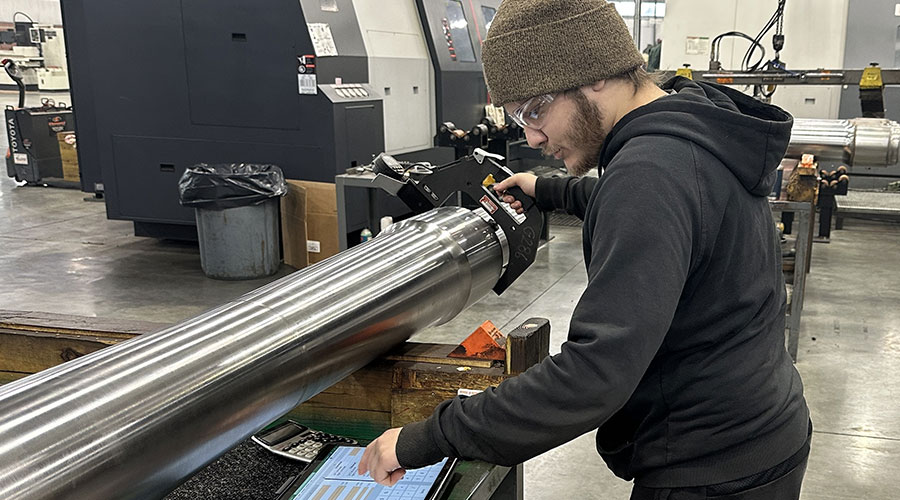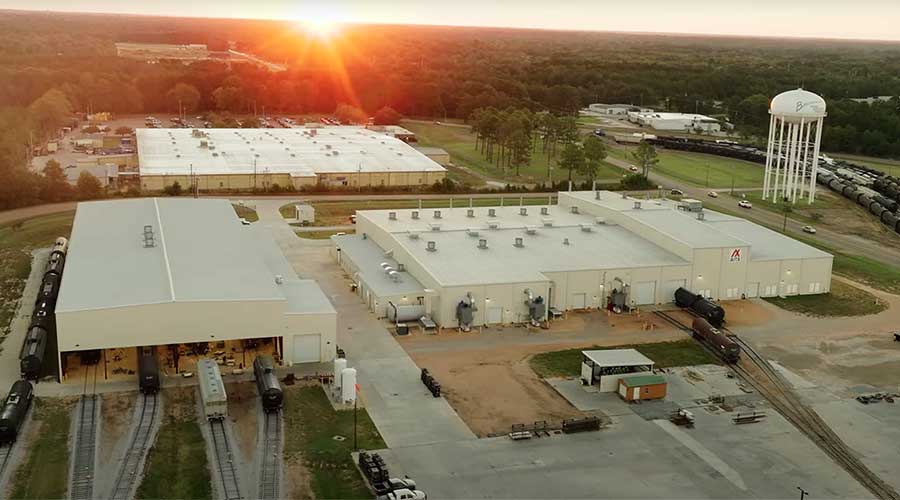Stay updated on news, articles and information for the rail industry
March 2010
Rail News: Mechanical
Class Is employ fuel-saving practices that promise stingier diesel usage
By Jeff Stagl, Managing Editor
Last year, the Class Is spent about $7.3 billion on fuel, which accounted for the second-largest portion of their operating costs after compensation and benefits. Yet, they reduced fuel costs between 42 percent and 56 percent compared with 2008's total primarily because diesel prices — and their carloads — dropped significantly from year to year.
But there's another reason their costs fell: ongoing conservation practices. During the past few years, Class Is have continued to acquire more fuel-efficient road locomotives and GenSet switchers, and retire older diesel-guzzling units; install Auto Engine Start Stop (AESS) devices on motive power to control idling; employ manual engine shut-down procedures; lubricate rail to reduce friction; and coach locomotive engineers to improve train-handling skills.
The practices paid off big-time in 2009. For example, Union Pacific Railroad — which has improved fuel efficiency more than 15 percent since 1998 — cut fuel expenses 56 percent to $1.8 billion and saved 40 million gallons of diesel.
However, "all the low-hanging fruit is gone" and it's becoming increasingly difficult to raise the fuel-efficiency ante, says CSX Corp. Assistant Vice President-Locomotive Planning and Utilization Andy John.
"We're doing things now that are more complex and expensive," he says.
Among them: distributed power-equipped trains, hydrogen fuel-cell locomotives, top-of-rail (TOR) lubricators and throttle-control software systems, which Class Is are testing or employing to further ratchet down their diesel consumption. They're also trying other measures — such as improving an intermodal train's aerodynamics — that don't necessarily offer significant savings.
"Not everything promises 'Big Kahuna' improvements — things that provide huge fuel savings don't come along often," says Mike Iden, UP's general director-car and locomotive engineering. "We can get small gains versus a 'Hail Mary' pass."
No matter how they're conserving fuel or by what amount, Class Is plan to do whatever it takes to reduce their consumption. Since crude oil prices are climbing — the average national price of diesel last month hit $2.83, up 33 percent year over year — they know it'll take a myriad of measures to ensure fuel costs continue to drop, as well.
"We try to take a multi-faceted approach to fuel management," says Canadian Pacific Locomotives Director Bob Goulet.
Total Team Effort
So does CSX, which last year cut fuel costs 53 percent to $849 million. For the past seven years, the Class I has employed a fuel process improvement team (PIT) charged with improving efficiency — as measured by gallons per gross ton miles — at least 1 percent annually via both tried-and-true and new methods. The cross-functional PIT includes representatives from the mechanical, purchasing, finance and other departments.
Last year, the team registered $62 million in fuel savings and improved efficiency 3.8 percent, says CSX's John.
"We usually hit 1.5 to 2 percent in improved fuel efficiency each year," he says.
In terms of long-running practices, the Class I continues to acquire more Evolutionª Series locomotives from GE Transportation. The locomotives consume 189,000 fewer gallons of fuel during their lifespan compared with units GE built in 2004, according to the locomotive builder. Since 2000, CSX has spent $1.5 billion to modernize and upgrade its fleet, and the railroad expects to acquire 50 more Evolution Series units next year, says John.
In addition, CSX continues to add GenSets to its switcher fleet. The Class I operates 15 units and plans to acquire another 10 to 15 GenSets in 2010. National Railroad Equipment Co. is retrofitting CSX's entire fleet of GenSets, which are expected to cut fuel consumption by nearly 10 million gallons.
"They're great machines, but we only use them for local service," says John. "We don't get the big fuel savings we get with the modern road fleet."
CSX also is registering fuel savings by continuing to install AESS devices to control locomotive idling; improve train sizes and horsepower-per-trailing-ton ratios; and coach engineers on optimal train-handling techniques. The Class I plans to roll out an engineer scorecard based on event recorder automated download data — such as power braking — to further improve train-handling skills, says John.
In the meantime, CSX is analyzing TOR lubricators to ensure trains consume less energy for pulling power, as well as to reduce wheel wear, he says. The railroad is equipping 14 trains with the onboard lubricating system as part of a test. The Class I also is testing GE's Trip Optimizer — which is designed to automatically control a locomotive's throttle — and a version of the Locomotive Engineer Assist Display and Event Recorder (LEADER®) system developed by New York Air Brake Corp. (NYAB) and used extensively by Norfolk Southern Railway.
Taking a Lead Position
Since 2004, when it began a pilot project with partners NYAB and the Federal Railroad Administration, NS has employed LEADER in the Winston-Salem District, which features the most "extreme" operating conditions, according to the Class I. LEADER is designed to continuously log a train's operating conditions, monitor fuel usage and create a statistical profile of an optimal run. Profiles are used to develop the most fuel-efficient run and help coach engineers on maintaining performance to eliminate unnecessary braking and throttle use, and conserve energy.
As of mid-2009, LEADER helped NS achieve fuel savings of about 25 percent on unit coal trains operating in the district with pusher engines. Average fuel savings, based on more than 430 loaded train moves, exceeded 17 percent.
Now, NS plans to broaden LEADER's deployment by rolling out the system in the Northern Region between Chicago and Croxton, N.J.
"We want to use LEADER on more than just coal trains," says Coleman Lawrence, NS' senior director of operations and locomotive control. "The Northern Region is critical because it has all types of terrain and different types of traffic, such as coal, intermodal and merchandise."
The railroad has equipped 150 trains with hardware, and 21 units with both hardware and software. In January, NS operated the first two production trains in the region between Pittsburgh and Chicago.
"We're still working the kinks out, getting crews trained ahead of the roll out," says Lawrence, adding that the project will involve about 800 engineers.
Only about 7.3 percent of NS' total route miles have been mapped in LEADER, but the routes represent a large proportion of annual ton-mile volume. The Northern Region roll out is expected to generate single-digit fuel savings, says Lawrence.
Distributing the Responsibility
Much larger savings could be realized by combining LEADER with distributed power (DP) — perhaps upwards of 25 percent to 30 percent, NS estimates.
"You'd get fuel savings that are unbelievable," says Lawrence.
NS has piloted two non-regular service unit coal trains in the Winston-Salem District with the lead and controlling pusher equipped with NYAB's LEADER and GE's DP.
"We need to do more work to fully integrate the systems," says Lawrence. "However, the potential is there."
CN already is deriving fuel-efficiency gains from DP. The practice enables the Class I to operate fewer and longer trains, and maximize advantages from an extended siding program, CN officials said in an email.
"DP-equipped locomotives' higher-power and higher-adhesion capabilities mean fewer locomotives are required to pull the same train weight," they said. "With more optimum matching of motive power to train weight, DP locomotives save fuel."
CN — which last year cut fuel costs 45 percent to $769 million — also is testing GE's Trip Optimizer system, as well as installing Wi-Tronix L.L.C.'s Wi-Tracker system on locomotives to maximize asset utilization and fuel savings. Wi-Tracker provides various software tools, including engine shut down and duty cycle, fuel monitoring and geo-mapping.
DP and software systems also are high on UP's list of fuel-saving measures. Last year, 65 percent of all train starts featured DP, which helps increase fuel efficiency, boost system velocity and improve safety, says UP's Iden.
"The goal for 2010 is to use distributed power on 75 percent of all train starts," he says.
Currently, UP determines the number of locomotives to assign to a train and sets system coupler limits according to a Tons-Per-Equivalent Powered Axel (TPA) system instead of a horsepower-per-ton system. Implemented in November 2008, TPA enables the railroad to better apply coupler limits and more accurately measure the speed and force required to move a train consist at any given point.
"Horsepower-per-ton is not discriminatory by train type and we found we were over-powering trains," says Iden.
UP also continues to cut fuel consumption by employing GenSets, which Iden helped pioneer in 2004. The railroad currently has 165 units in service, including 98 in Texas, 65 in the L.A. Basin and six at Roseville Yard in Sacramento, Calif. Compared with a GP38 locomotive, GenSets provide fuel savings between 16 percent and 25 percent, says Iden.
Other fuel-conserving practices call for installing AESS devices on new and retrofitted units, and stressing manual shutdown as an "AESS overlay," he says.
In addition, UP continues to stress its Fuel Masters program, which monitors locomotive engineers' fuel-consumption performance in each territory. The Class I uses a two-month performance snapshot to calculate individual consumption rates. Each month, engineers in the top 15 percent to 20 percent are rewarded with personal-vehicle gasoline gift cards.
About 6,800 engineers and 150 routes currently are included in the program, says Iden, adding that Fuel Masters reduced fuel usage by 4 percent in 2008 and by a slightly lower percentage in 2009 because of lighter traffic.
Kansas City Southern is reaping fuel-conserving benefits from an engineer reward program, as well. Through the quarterly program, managers of operating practices choose an engineer from each territory who excels at employing train-handling skills that reduce fuel burn; shutting down locomotives that aren't used within 30 minutes; and following locomotive-isolation procedures per territory and train speed. Chosen engineers receive personal-vehicle fuel gift cards.
The Class I also is seeking fuel savings by continuing to equip AC4400, ES44AC and SD70ACe units with AESS devices, and "aggressively pursuing additional repower initiatives" to revamp its aging four-axle fleet, KCS officials said in an email.
This year, the railroad plans to repower five GP locomotives using Electro-Motive Diesel Inc.'s 2,000-horsepower 710ECOª Repower technology, which offers a 25 percent reduction in fuel usage compared with a conventional locomotive. KCS recently rebuilt nine GP and two SD units using the 710ECO system for Kansas City Southern Railway; the Class I rebuilt 16 Kansas City Southern de MŽxico S.A. de C.V. locomotives with the technology, KCS officials said.
Additional fuel savings might be wrung from a software system the Class I began to test last month. KCS is analyzing EMD's Smart Consist, which is designed to determine the most fuel-efficient train consist based on load demand and locomotive type.
An Optimal Position
Meanwhile, CP already is rolling out fuel-conserving software. Last year, the Class I awarded GE a contract to equip 200 Evolution Series locomotives with the Trip Optimizer, which is designed to calculate a train trip's "fuel optimal" speed and then automatically control a locomotive's throttle to maintain that planned speed.
CP tested Trip Optimizer on 18 Evolution Series locomotives operating in three different subdivisions featuring mountainous and prairie terrain, and winding track. The Class I found the system provided fuel savings ranging from 6 percent to more than 10 percent depending on the territory.
"It deals with energy management," says CP's Goulet. "The system is like cruise control."
The Class I also is using other throttle-control software and AESS devices, operating larger horsepower-efficient and DP-equipped trains, and modernizing the locomotive fleet to cut fuel usage. CP's fleet, the youngest in North America, averaged 17 years as of Dec. 31, says Goulet. The practices last year helped CP reduce fuel costs 42 percent to $580.2 million.
In addition, the Class I is coaching and reviewing engineers' train-handling performance to eliminate power braking and increase the use of dynamic braking, and employing more TOR lubricators to cut friction. For more than one year, CP has used 250 TOR lubricators on a corridor between Calgary, Alberta, and Vancouver, British Columbia.
"We're getting a 30 percent reduction in lateral forces on curves," says Goulet, adding that the railroad is considering whether to install the lubricators on other corridors that feature many curves and different grades.
High on Hybrid
BNSF Railway Co. is implementing a new fuel-conserving practice, too. On Jan. 28, the Class I unveiled a hydrogen fuel-cell locomotive that will be used to switch cars at a Los Angeles yard. Developed with Vehicle Projects Inc. since 2008, the hybrid switcher relies on a fuel-cell prime mover and lead-acid traction battery to generate power instead of a diesel engine. BNSF plans to continue developing the emerging technology, which might be used in a road locomotive in the future.
For now, the railroad — which last year cut diesel costs 50 percent to $2.4 billion — expects to keep reaping benefits by coaching engineers and rewarding the most fuel-efficient ones through a Fuel MVP program.
Staying on top of diesel usage is a never-ending challenge for Class Is. With their traffic already showing small signs of a rebound in early 2010 — and a healthier freight demand uptick on the short- and long-term horizons — a lot more locomotives soon will be factored into the train-pulling equation.
To reduce consumption, it's vital that Class Is keep plugging away at what's become their primary fuel-management goals.
"We want to reduce the energy used to pull a train, create energy as efficiently as we can, match power needs to each train and control idling," says CSX's John.
Regional to Register Fuel Savings From Idle-control SystemsA Northeast regional also is employing locomotive technology to significantly reduce fuel consumption. Providence and Worcester Railroad Co. (P&W) plans to install Auxiliary Power Units (APUs) on 17 locomotives to control idling. Manufactured by Power Drives, and installed and serviced by PowerRail Distribution Inc., the APUs are designed to save several gallons of diesel per hour compared with an idling locomotive's fuel consumption. The 545-mile P&W obtained funding for the APUs through a U.S. Environmental Protection Agency "Diesel Emission Reduction Act" grant. The regional also recently installed 13 Automatic Engine Start Stop (AESS) systems supplied by GE Transportation to reduce locomotive idling. The systems are designed to provide fuel savings up to 10 percent on AESS-equipped switchers and up to 3 percent on AESS-equipped road locomotives, according to GE. In addition, railroads can save about $8,000 annually in fuel expenses per road locomotive. — Jeff Stagl |


 2025 MOW Spending Report: Passenger-rail programs
2025 MOW Spending Report: Passenger-rail programs
 Gardner steps down as Amtrak CEO
Gardner steps down as Amtrak CEO
 Guest comment: Oliver Wyman’s David Hunt
Guest comment: Oliver Wyman’s David Hunt
 Women of Influence in Rail eBook
Women of Influence in Rail eBook
 railPrime
railPrime









